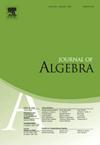残差交集与舒伯特变异
IF 0.8
2区 数学
Q2 MATHEMATICS
引用次数: 0
摘要
受Ulrich[26]和Huneke-Ulrich[25]工作的启发,我们描述了一种模式来表明某些相反嵌入的Schubert变体(由该模式定义)的理想是通过取两个(几何连接的)相反的Schubert变体(我们称之为Ulrich对)的残差相交产生的。此模式对于ADE类型是统一的。所讨论的舒伯特变分的一些自由分辨率对于有限自由分辨率的结构是重要的。对于我们的模式,我们的证明是理论性的和统一的,然而,使用逐个分析和计算机的帮助来推导结果是可能的。本文章由计算机程序翻译,如有差异,请以英文原文为准。
Residual intersections and Schubert varieties
Inspired by the work of Ulrich [26] and Huneke–Ulrich [25], we describe a pattern to show that the ideals of certain opposite embedded Schubert varieties (defined by this pattern) arise by taking residual intersections of two (geometrically linked) opposite Schubert varieties which we call Ulrich pair. This pattern is uniform for the ADE types. Some of the free resolutions of the Schubert varieties in question are important for the structure of finite free resolutions. Our proof is representation theoretical and uniform for our pattern, however it is possible to derive our results using case-by-case analysis and the aid of a computer.
求助全文
通过发布文献求助,成功后即可免费获取论文全文。
去求助
来源期刊

Journal of Algebra
数学-数学
CiteScore
1.50
自引率
22.20%
发文量
414
审稿时长
2-4 weeks
期刊介绍:
The Journal of Algebra is a leading international journal and publishes papers that demonstrate high quality research results in algebra and related computational aspects. Only the very best and most interesting papers are to be considered for publication in the journal. With this in mind, it is important that the contribution offer a substantial result that will have a lasting effect upon the field. The journal also seeks work that presents innovative techniques that offer promising results for future research.
 求助内容:
求助内容: 应助结果提醒方式:
应助结果提醒方式:


